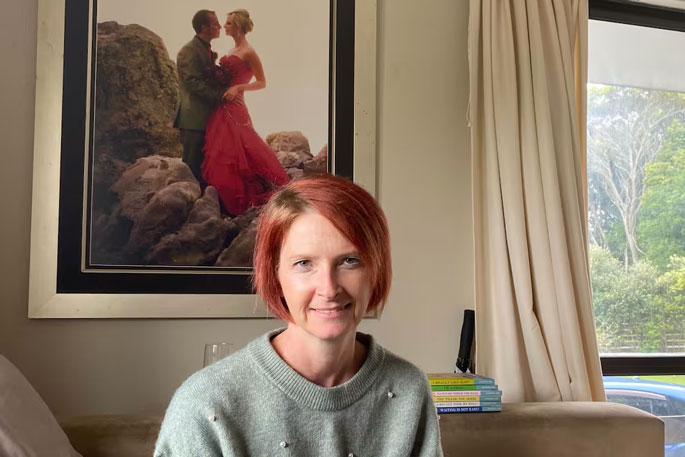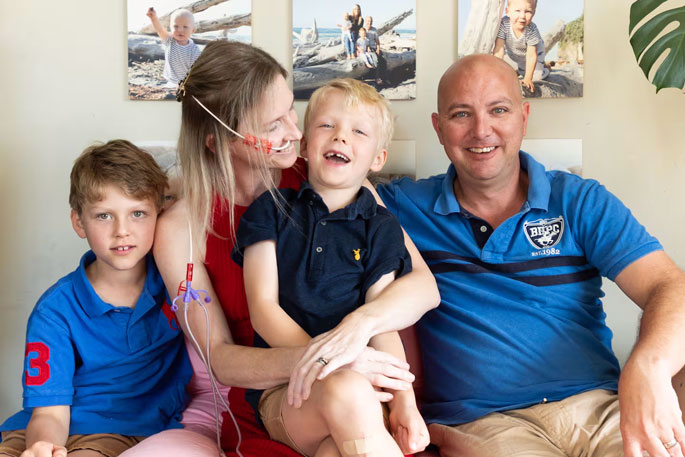On July 23, Pam Coburn had her first bite of food in more than two years.
The 41-year-old was previously tube-fed due to a diagnosed rare abdominal condition that caused searing pain when she swallowed food or liquid – abdominal vascular compression syndromes (AVCS).
In July, she went to Germany to have surgery unavailable in New Zealand. Without it, Coburn expected to die within the next five years.
Coburn said that after surgeries she was able to eat and walk unaided again, and her results had been “phenomenal”.
NZ Herald reported in September two recent New Zealand medical reviews found no robust evidence for the surgery, but there was a risk any perceived relief it provided could be a placebo effect – something Coburn disputes in her case.
Health NZ says careful assessment of how it diagnoses and treats AVCS is required because available evidence was of “low quality”.
It is setting up a specialist team to help develop a “consistent” approach.
‘I woke up and I was hungry’
Coburn lives in Athenree, near Tauranga, with husband Jon and their sons, Benny, 8, and Ollie, 6.
Coburn was diagnosed with Ehlers-Danlos Syndrome (EDS) in September 2023 and a comorbidity Abdominal Vascular Compression Syndromes (AVCS) in March 2024.
EDS is a group of genetically inherited connective tissue disorders typically characterised by bendy joints, stretchy skin and fragile tissue.
Vascular compression syndromes are a group of conditions occurring when blood vessels under intense pressure restrict blood flow, which can cause dizziness and extreme pain. Coburn said she was often bedridden and plagued by migraines.
Told she needed abdominal compression surgery in Germany, she fundraised $160,000 in four months, and flew out on July 14.
After scans at a clinic in Leipzig, she had abdominal compression surgery in Dusseldorf on July 23.
The surgery wrapped a sliced tube around her “squashed” left renal vein to stop it being compressed.
“I had the surgery, and I woke up and I was hungry - and I hadn’t had that feeling in I don’t even know how long,” she told the Bay of Plenty Times at her home this month.
 Pam Coburn pictured in April pre-surgery when she was drinking and eating through a tube. Photo / Alex Cairns.
Pam Coburn pictured in April pre-surgery when she was drinking and eating through a tube. Photo / Alex Cairns.
She drank some water and ate an ice block. The next day, she had “a couple of teaspoons” of soup.
As her recovery continued in Germany, she saw improvements in her abdominal area but her migraines were getting worse.
Three unexpected surgeries
Coburn said her post-surgery migraines were causing her to vomit and noise would “send me into overdrive”.
After four weeks, Coburn was unexpectedly told she needed surgery for jugular vein compressions, costing $50,000.
Coburn said over three surgeries in August, a surgeon shaved down a bone compressing on her jugular vein to relieve the “pressure” in her brain.
Post-surgery, the migraines were gone and her “head feels clearer each day”.
She and Jon arrived back home on September 2.
In total, the trip cost them $250,000. The $90,000 not covered by fundraising came out of their superannuation funds, a $10,000 superannuation loan and two $5000 loans from loved ones.
‘It’s life-changing already’
Ten weeks post-abdominal surgery, she said the improvements were “far beyond our expectations”.
“The difference is huge … it’s life-changing already.”
Coburn said the biggest highlight was hugging her sons after being away for seven weeks. Another was living a life “that resembles kind of normal”.
“I feel more like myself. I was a shell of myself.”
 Pam Coburn has noticed "life-changing" results after having surgery in Germany. Photo / Megan Wilson.
Pam Coburn has noticed "life-changing" results after having surgery in Germany. Photo / Megan Wilson.
She had been out doing things with her family and gradually increasing her food intake and distance she could walk each day (1.2km).
“The difference is just phenomenal, really.”
Coburn said she sometimes walked with a cane and had days with abdominal pain was similar to pre-surgery, needing to curl up with heat packs and sleep.
“Then it will just go away, which is really lovely. Whereas before, that never happened. It’s good to know that when they come, it does pass.”
‘A second chance at life’
While Coburn expected her recovery to take a year, she was feeling “so much better”.
“I have dreams again, I can eat again, I can go out with my family … I have been given a second chance at life.”
 Pam Coburn pictured in April pre-surgery with her husband Jon Coburn and their children, Benny (left) and Ollie. Photo / Alex Cairns.
Pam Coburn pictured in April pre-surgery with her husband Jon Coburn and their children, Benny (left) and Ollie. Photo / Alex Cairns.
The couple had decided to take on more debt to buy a caravan to take their sons on a long-awaited holiday.
“There was a time when I didn’t think I’d see my kids become teenagers, and now I can not only see that happen but actually be able to be involved in their lives too.”
Coburn said she would love to see a philanthropist open a clinic in New Zealand following the framework of the German one and planned to continue advocating.
She said the risk of travelling while so sick was high, and many patients could not afford the steep cost.
Review deems surgery ‘experimental’
Last year, a review led by the Northern Region Clinical Practice Committee focused on an abdominal vascular compression called median arcuate ligament syndrome (Mals).
Hamilton vascular surgeon Dr Chris Holdaway, who has advocated for bringing the surgery to New Zealand, surveyed patients and visited Germany to see it performed, previously told the Bay of Plenty Times this was one of four major abdominal vascular compressions.
Coburn said her AVCS diagnosis included two of the four plus abnormalities with Mals.
In a letter on December 4, committee chairman Dr James Le Fevre said the available evidence for the diagnosis and treatment of Mals was low quality with no randomised control trials.
The committee’s consensus was the surgical procedure could “not be reasonably described as a well-established treatment with proven efficacy in clinical trials or proven efficacy in regular practice”.
Le Fevre said vascular compression syndromes could be a “plausible explanation” for the symptoms associated with EDS, but those “could actually be functional” (without an obvious physical cause). That meant there was a risk that the surgery could provide no relief of the symptoms other than a placebo effect.
There could be an association with EDS and AVCS and it might be possible for individuals to have multiple co-existing vascular compression syndromes.
However, outside of sparse case reports, the only available data supporting this was from an observational study led by the German surgeons, which the letter said had a “number of limitations”.
Le Fevre wrote the reported associations “may represent a highly meaningful medical discovery” but this required further research.
In the meantime, multiple simultaneous vascular release surgeries in one patient should be considered “on the spectrum of innovative and experimental surgery”.
Health NZ responds
A statement from Health NZ said it was making good progress in work to develop a “pathway for people with complex vascular problems”.
It said EDS was an extremely rare and evolving group of conditions, with poor or low-quality evidence for treatment. Diagnosis must be “carefully considered”.
“The studies that are available are poor due to inconsistent reporting of participants’ characteristics and the use of multiple diagnostic processes. Additionally, outcome reporting is relatively short-term in most studies, and reported outcomes were highly variable.”
Health NZ was establishing a vascular multidisciplinary team of specialists to develop a nationally consistent and evidence-based approach to the diagnosis and treatment of relevant conditions.
This would ensure patients received the “most appropriate” care, noting no one treatment would always be successful and no treatment or surgery could remove the underlying problem.
The statement said AVCS could be a complication of EDS. It also occurred in other conditions and might arise as a consequence of weight loss.
“A very careful assessment of how we diagnose and treat Mals in New Zealand is required because the available evidence is of low quality, with no published randomised controlled trials.”
It would also be covered by the review.
The team would determine whether a case was best managed without surgery or recommend surgery that could be done via the high-cost treatment pool - application-based funding for overseas treatments - if necessary.
Health NZ said patients were managed in a multidisciplinary manner including primary care, allied health, and specialists when needed and received treatment that could involve pain management, physiotherapy and splinting.
“For these types of conditions, we find that many patients respond well to treatment without the need for further interventions. Vascular compression can be a complication of EDS and a variety of vascular surgery services are available in New Zealand.”
Surgery may not always be considered the best option, particularly because the level of complexity and uncertainty of Mals varies. In these instances, an individual may still wish to receive treatment overseas, but will need to fund it themselves.



0 comments
Leave a Comment
You must be logged in to make a comment.